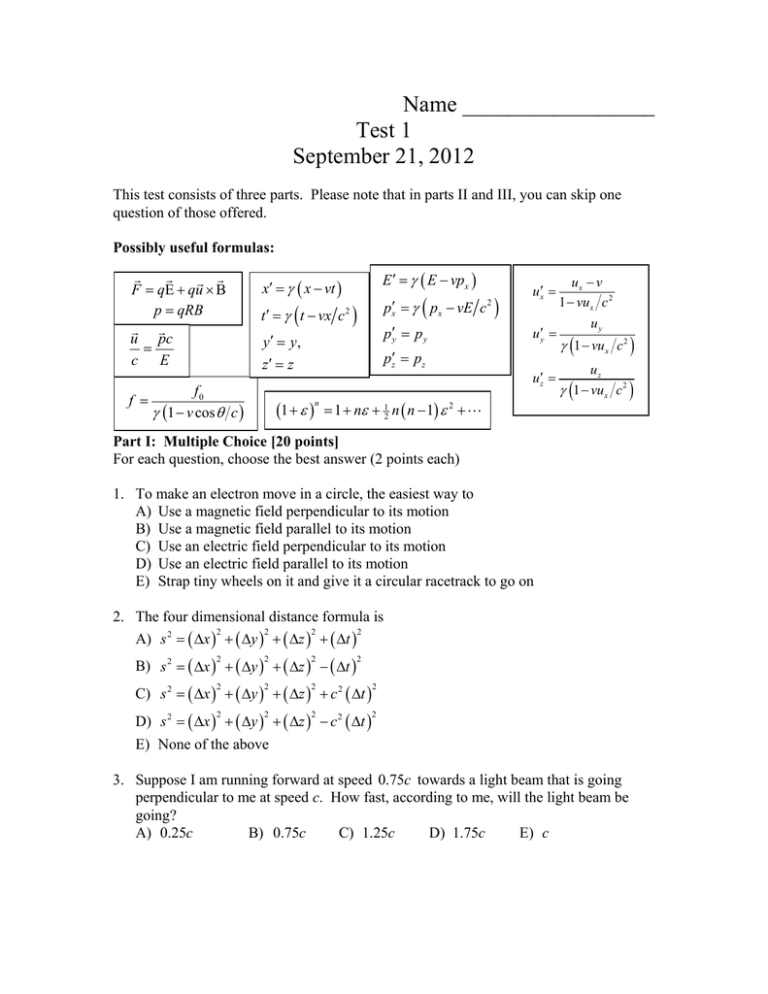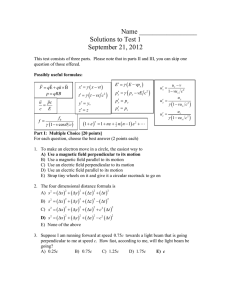Name _________________ Test 1 September 21, 2012
advertisement

Name _________________ Test 1 September 21, 2012 This test consists of three parts. Please note that in parts II and III, you can skip one question of those offered. Possibly useful formulas: F qE qu B p qRB u pc c E f E E vpx x x vt px px vE c t t vx c 2 py p y y y, z z f0 1 v cos c pz pz 1 n 2 u x ux v 1 vu x c 2 uy u y 1 vu x c 2 u z uz 1 vu x c 2 1 n 12 n n 1 2 Part I: Multiple Choice [20 points] For each question, choose the best answer (2 points each) 1. To make an electron move in a circle, the easiest way to A) Use a magnetic field perpendicular to its motion B) Use a magnetic field parallel to its motion C) Use an electric field perpendicular to its motion D) Use an electric field parallel to its motion E) Strap tiny wheels on it and give it a circular racetrack to go on 2. The four dimensional distance formula is 2 2 2 2 A) s 2 x y z t B) s 2 x y z t 2 2 2 2 C) s 2 x y z c 2 t 2 D) s 2 x y z c 2 t 2 2 2 2 2 2 2 E) None of the above 3. Suppose I am running forward at speed 0.75c towards a light beam that is going perpendicular to me at speed c. How fast, according to me, will the light beam be going? A) 0.25c B) 0.75c C) 1.25c D) 1.75c E) c 4. Suppose you have a stretched spring. Suppose you now allow the spring to relax to its unstretched length. According to relativity, does the mass change? A) Yes, it increases B) Yes, it decreases C) Yes, it will definitely change, but there is insufficient information to tell how D) Maybe, it depends on additional details, like how fast it changes E) No 5. If I am standing still and a rocket goes past me, I would say that the clocks on the rocket go ________, and the person on the rocket would say my clocks go ________. A) slower, faster B) faster, slower C) slower, slower D) faster, faster E) Insufficient information 6. If you have a collection of many objects moving at different speeds in different direction, how would you find the effective mass of the whole collection? A) Add up the energies of all the particles, then divide by c2 B) Add up the energies of all the particles, then divide by c 2 C) Find the total momentum and energy, then use M 2 c 4 E 2 c 2 p 2 D) Add up the total momentum, then divide by the average velocity E) Add up the masses of all the pieces 7. Another way to think of the Lorentz transformation (called Lorentz boost in class) is A) It’s like a rotation in space-time, mixing time with space B) It is a formula for how coordinates appear to transform, because the objects that measure them are all Lorentz contracted C) Spacetime, like all objects in special relativity, is somewhat compressible, which leads to the distortions D) It is a formula that has to do with clocks that run on light waves; if we used ordinary pendulum clocks, the formulas would be different E) It is caused by the changing length of objects when you accelerate them 8. If a particle of mass m approaches the speed of light, what would the limit of the momentum and energy be? A) p mc , E 12 mc 2 B) C) D) E) p mc , E mc 2 p , E mc 2 p mc , E p, E 9. Which of the following statements is false in special relativity? A) Energy is conserved B) Mass is conserved C) Momentum is conserved D) There are no rigid objects E) It is generally impossible for different observers to agree on simultaneity 10. What fundamentally makes equations like F kqq r 2 for the force between two charges unacceptable in special relativity? A) Lorentz contraction causes the charges to change size, and hence get bigger or smaller, and this isn’t concluded B) The distance r will be different as viewed by different observers C) Since the formula F = ma is false in relativity, there is no point in calculating the force D) This formula assumes instantaneous action at a distance, which is impossible in special relativity E) This is a force of electromagnetism, which is not compatible with relativity Part II: Short answer [20 points] Choose two of the following questions and give a short answer (1-3 sentences) (10 points each). 11. Suppose that according to one observer, event A occurs before event B. Under what circumstance, if any, will all observers agree that event A occurs before event B? 12. Two stars are in orbit around each other, and each produces a radio wave (a kind of light) with a frequency of 1420.45 MHz, as viewed by an observer standing on the star (if that’s possible). Explain how this frequency would change as viewed from Earth. Predict which (if either) would have an increase/decrease in the frequency. To Earth A B 13. In a homework problem, you found that a “bunch” of protons, when it passes through the Atlas detector, as viewed by us is much shorter than the Atlas detector, but if you were moving along with them it is much longer than the Atlas detector. But surely the protons are either all in the detector at the same time or not. Resolve this apparent paradox. Part III: Calculation: [60 points] Choose three of the following four questions and perform the indicated calculations (20 points each) 14. The probability of a particle lasting a proper time is given by P e 0 , where 0 is the mean lifetime. It is observed that for a group of B+ mesons moving at 0.99630c, after traveling a distance d = 0.680 cm, only 30.3% of them still exist. (a) How long did they last as viewed in our frame? (b) How long would they have lasted as viewed by someone moving with them? (c) What is the mean lifetime 0 of the B+ meson? 15. A pair of spherical spacecraft are each passing me at high velocity in opposite directions. They are actually spherical, but because of their high speed, they appear as ovals 40 m 32 m in diameter. (a) Which direction (horizontal or vertical) are they actually moving? What would be their diameter if someone were moving along with them? (b) How fast are each of these spacecraft moving, according to me, as a fraction of c? (c) How fast is one of these spacecraft moving, according to the other spacecraft, as a fraction of c? 16. An X particle slams into a proton at rest (m = 938 photon MeV/c2), causing it to annihilate with it to make two (massless) photons, each with energy E = 1876 MeV, photon and moving perpendicular to each other, as sketched at proton right. X (a) What is the momentum of each of the final state photons, in MeV/c? What is the total momentum? (b) What is the momentum and energy of the initial X particle? (c) What is the mass (in MeV/c2) of the X? 17. A rocket with mass M = 1000.0 kg is being sent to a distant star. It is supposed to be accelerated from rest up to v 2.80 108 m/s by firing its rockets at a steady rate for one year ( t 3.156 107 s ) (a) What is the initial energy and momentum of the rocket ship? What is the final energy and momentum of the rocket ship? (b) What force (in N) is required to achieve this final speed in one year? (c) How far, in light-years, does the rocket travel in this first year? ( 1 ly c y 9.47 1015 m )



